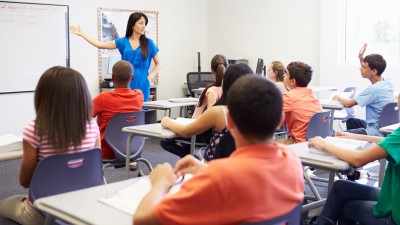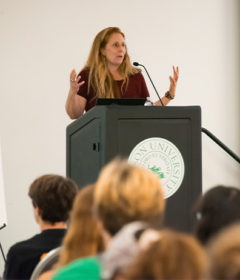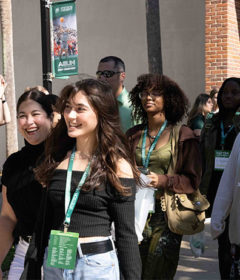Mass Exodus: A Crisis in Teaching
by Michael Candelaria
The numbers on the chalkboard aren’t difficult to calculate.
National studies reveal that 40-50 percent of new teachers in kindergarten through 12th grade classrooms leave the profession within the first five years of teaching, and about 13 percent of the nation’s 3.4 million K-12 teachers shift schools or leave the profession each year, collectively costing states up to $2 billion. (More about the research.)
Simply put, new teachers are struggling in the classroom.
A National Center for Education Statistics survey found a correlation between the level of support and training provided to new teachers and their likelihood of leaving after the first year, revealing that poor retention is not a question of commitment, but a problem with support.
A peek behind the curtain shows there is yet more to the equation: more academic responsibilities for teachers and more social challenges in the classroom, resulting in greater pressure points and subsequent failure for both teachers and their students.
Challenging Times
An acceleration of K-12 curriculum content is a prime example of one challenge facing teachers.
“What I might have been studying when I was in sixth or seventh grade can now be found in the curriculum in third or fourth grade,” explains Chris Colwell, Ed.D., associate professor and chair of Stetson University’s Department of Education, who spent 34 years as a K-12 teacher and administrator.

“So the amount of content, and the ability to teach that content, provides a greater challenge for elementary teachers than it was in the past,” says Colwell. “The 21-century elementary school teacher has to come to the classroom with a much deeper understanding of core-content knowledge.”
At the same time, many colleges across the country are failing to change with the times. Teachers often are still being taught using old methods and with little exposure to new technologies. Also, in many school districts, ongoing learning opportunities for K-12 teachers are limited.
Across the United States, college students majoring in education are falling short on core-knowledge depth, are not being adequately prepared to deal with classroom issues in an increasingly demanding environment, and don’t have the ability to foster blended learning — the use of technology-enabled tools and curricula in concert with traditional teaching methods.
The bottom line: many teachers aren’t learning how to teach well enough, are suffering from lack of administrative support, and are becoming frustrated and overwhelmed to the point of leaving their jobs.
Wanted: Solutions
As a result, new approaches are needed, with the understanding that effective teaching requires a deep knowledge of the subject, an understanding of how people learn, and an ability to use principles of learning and teaching to stimulate student learning and achievement.
That’s exactly what is happening at Stetson.
Recognizing the need for new ideas and methods for teaching, Stetson and a handful of partners have their sights set on delivering a new model of excellence in educating prospective teachers.
In December 2014, Stetson — along with Bethune-Cookman University, Volusia County Schools and the New Teacher Center — was awarded a $1.1 million grant from the Florida Department of Education to create and launch the Volusia Center for Excellence in Education.
The goal: strengthen and enhance the skills of teachers as well as their knowledge of core subject matter. In-depth coursework, labs, field experiences and clinical education training will be required for all teachers going through the program. With committee work underway, all initiatives are scheduled to ramp up during the next several months.

“This is a very exciting opportunity to partner with our colleagues to enhance teacher education throughout Florida and beyond,” said Karen Ryan, Ph.D., dean of Stetson’s College of Arts & Sciences, noting that an effective program has been in place for years. “This grant will allow us to make aspects of our curriculum — especially the thorough mastery of content — more widely available to teacher education programs.”
“This collaborative effort will develop better trained teachers who will continue to receive peer support throughout their first year teaching with Volusia County Schools,” says Margaret Smith, D.Ed., superintendent of schools for Volusia County.
Academic rigor, performance evaluation and classroom relevancy will be the focal points, as the model takes shape for the roughly 120 Stetson students who are learning to become teachers.
For example, Stetson interns teaching at schools will have a college professor working with and evaluating them, as well as a supervising teacher at the school. In addition, a teacher specialist from the K-12 school district, whose full-time job is to evaluate and assist professional practicing teachers in the field, will work with them. As such, the same instructional specialists working with a five-year veteran in the school system will assist interns, too.
“We are licensing teachers, and that license, that credential, means a lot to us,” said Colwell, who serves as the grant’s Principal Investigator. “So, we want that credential to be equal to, and superior to, the credential of an experienced teacher.”
As part of the model, Volusia County Schools has committed to offer student teachers employment at the end of their junior years, if they are able to demonstrate an established level of proficiency.
“This initiative will provide a seamless transition for new teachers from their university pre-service programs to their early experiences co-teaching in the classroom working alongside a qualified teacher and on through their first two years on the job,” says Jordan Brophy-Hilton, vice president of Program Partnerships at New Teacher Center. “The result will be improvements in both teaching quality and student learning.”
Successful Programs
Efforts elsewhere in the country are yielding strong results. In Chicago, young teachers are finding help from the New Teacher Center’s e-Mentoring for Student Success program, which brings together new and veteran teachers and university professors to share ideas and experiences within a structured curriculum. The program is built around a Facebook-like academic social platform where discussions and forums take place. The eMSS program was created in partnership with the National Science Teachers Association to connect new teachers with each other and with mentors.
At Hillsborough County Public Schools in Tampa, a teacher induction program created by the New Teacher Center has increased new-teacher retention rates from 72 percent three years ago to 86 percent a year later and with further improvement expected.
Those efforts and others are part of new thinking — and an emerging new model — that education leaders like Colwell believe will provide needed solutions in the future.
“We’re not interested in our graduates taking three or four years to get really good at their craft,” Colwell concludes. “We want them to walk in the door ready on day one.”
Stetson University Department of Education is accredited by the National Council for the Accreditation of Teacher Education and fully approved by the State of Florida for teacher certification. Programs are aligned to meet the State of Florida’s Subject Area Competencies as well as the Florida Educators’ Accomplished Practices.



